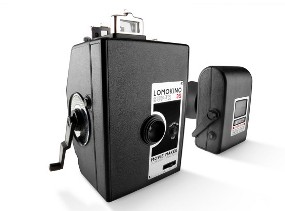
Named Super 35 LomoKino Movie Maker, this tool is capable of recording video with a roll of 35mm film. The result? still carries the characteristics of the image produced by the Holga and Diana, LomoKino able to produce an analog-style video with the old school colors.And that makes it look more classic is that the video is 'dumb' or without sound. Yes, this antique tools are not equipped with a hotshoe that is used for mounting the microphone, but that is the unique characteristics of LomoKino.

LomoKino equipped with 25 mm fixed lens aperture of f/5.6 to f/11. For the frame rate, LomoKino able to record 144 images in 60 seconds.To enjoy the short film LomoKino recording, users can use the bundled LomoKinoScope the price of USD 100 is LomoKino without bundlingan marketed at a price of $ 80 or RP 700 thousand.
Lomography has unveiled the LomoKino 35mm film camera, a modern take on one of the first film-capturing technologies invented, all wrapped in a retro-style form factor.
Taking pretty much any 35mm film available the LomoKino comes with some handy features, with a volume indicator you can easily see how much you've got left and when the film runs out, a convenient red flag pops up on the top of the camera.
To get started all you have to do is insert the film and then start turning the advancing crank and you're off, almost makes you wonder how tech got so complicated.
Despite being based on such age-old technology the LomoKino also features a focusing function for objects less than one meter, just press the close-up button and it'll focus in on the subject.
Finally to view all your wonderful retro-creations you'll need a viewer, and Lomogrophy just so happen to have one as well, made in partnership with the LomoKino.
Make all the hipster jokes you like. Fashionable film photography could be all that lies between us and the demise of film. With camera manufacturing and film stock going out of production, enthusiasts – both the inventors/merchandisers and users – are having to rebuild the film revolution from scratch. And while this site’s name has “digital” in the title, make no mistake: creative work with light and motion is dependent on maintaining traditional techniques for the full spectrum of choice.
That’s why it’s good news that today, Lomography has a motion camera. True to Lomo’s experimental roots in art student visual play, it’s not really a movie camera in the traditional sense. It’s a throwback to the beginnings of motion film, in many ways, down to the hand crank and jerky, slow-framerate capture. You could use it to do individual frames, timelapse style, or crank up to about 3-5 frames per second.
For visualists, it looks like brilliant, experimental fun, and I’m already thinking of ways to combine this “analog” workflow with digital tools that embody the same spirit. And Lomo seems to be going to digital hybrids, too, encouraging uploads to Vimeo. That’s good news – I can’t say I’ve absolutely loved Lomography’s own web photo sharing site, which can be clunky; seeing them embrace Vimeo seems very good, indeed. The design, which I hope to check out later today if I can grab one in Berlin, has some interesting features:
solid – camera doesn’t feel cheap or ‘plasticy’ and has some heft to it
- well built – unlike my Holga’s, it doesn’t feel like it’s going to break simply by advancing the film
- small – fits easily in my hand and can be tucked away in your jean or cargo short pockets if you needed to
- awesome wide angle glass lens – 17mm on a ‘full frame’ 35mm film camera is fabulous…that is all.
- great focal distance – you can easily switch between 0.4-0.9m or 0.9m to infinity focus distance which means you can get really close to your subjects with that wide angle lens
- Fixed focus 1m+; 0.6-1m macro mode
- Continuous aperture – a departure for the “sunny / cloudy” mode on Lomos. f/5.6 – f/11. (Amusingly, they still recommend switching between the extreme settings based on whether it’s sunny or cloudy.)
- A roughly 1/100 shutter, for cranking up to 3-5 fps. (This is where digital gets interesting to me – think about processing between frames.)
- Hot shoe and flash. Obviously, you want a flash that recharges quickly, but the flash could be the coolest feature here.
- Easy 35mm processing. Lomo suggests scanning with a flatbed. Time to hit eBay for a flatbed. Here, too, I could see some interesting DIY solutions and hacks.
{ 1 comments... Views All / Post Comment! }
I love lomography. Probably very important to camera enthusiast out there.
Post a Comment
Thank for comment.